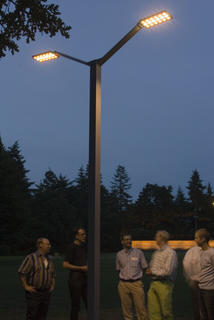
From
Davy Warren comes this interior shot showing some serious streetlight action. It's a sodium sandwich. From the left, we have low-pressure sodium [SOX], mercury-vapour [hurrah!] and high-pressure sodium [SON], all ensconced in attractive Thorn Gamma 6 post-top lumieres. Davy's site has a good selection of historic streetlights, focussing on the street-furniture aspects of lumiere design and development. Geographically, he concentrates on the South Devon area but there's also a page of photographs from Berkshire and Oxfordshire.
Next, we have Matthew Eagles'
soxlamps.com , a site celebrating the low-pressure sodium streetlight. We differ on the relative merits of these things, but I applaud a well-written, informative site which infuses a bit of good old personal passion into what is often considered a rather dry interest. The site also contains a clear explanation of the tech powering discharge lamps. And I have to admit that I do rather enjoy partaking in the atmospherics produced by the ignition sequence of the once-ubiquitous SOX lamps, as they fire red against the darkening sky. Actually, Matthew goes into some detail on this ignition sequence; there's colour charts! And timings!
Indeed, he cites his childhood fascination with this colour-changing ignition process as the inspiration behind his interest in street-lighting. In a different way, it was probably mine too. I had a dream. Cancel the MLK voice, I was six. As I trotted home from school past the wicked witch's house and an enchanted leafy glade, the gloaming dusk seemed to take on an ominous tone. I couldn't put my finger on the difference, but it was there. The birds still sang, the wind still rustled the leaves, the chimneys of the houses still discharged their Coalite trails speaking of warmth and comfort, but something was definitely amiss. As darkness came, the reason took form. The streetlight outside my bedroom window was not shining it's usual soft silvery-white, the colour of moonlight. Like every other light on the crescent, it had turned blood red. And I knew nothing would ever be the same again.
Waking to the reassurance of mercury-vapour normality, I put the dream aside and tried to learn how to do fractions. Many [oh alright, thirty-five bloody hell] years later, my childhood home is no more. Razed to the ground in the mid 80's, one of the few reminders of it's moment in space is the decaying lamp-post, now propped up with external trusses to stop it falling over and, in 2006, still illuminating this overgrown and forgotten corner of earth. In the early evening, this light will be observed as a deep red glow; a bloodlight spreading through the mass of foliage as the low-pressure sodium vapour lamp goes about it's business.
click here for latest posts
 Hoh yes, my friends. In a webtastic Streetlights exclusive and thanks to the server-space of that nice Mr. R. Murdoch, I am now making available my very own Song to the Streetlights. You'll find the song Hurricane Lamp available for free download, along with a couple of others [varying streetlight-quotient].
Hoh yes, my friends. In a webtastic Streetlights exclusive and thanks to the server-space of that nice Mr. R. Murdoch, I am now making available my very own Song to the Streetlights. You'll find the song Hurricane Lamp available for free download, along with a couple of others [varying streetlight-quotient].


